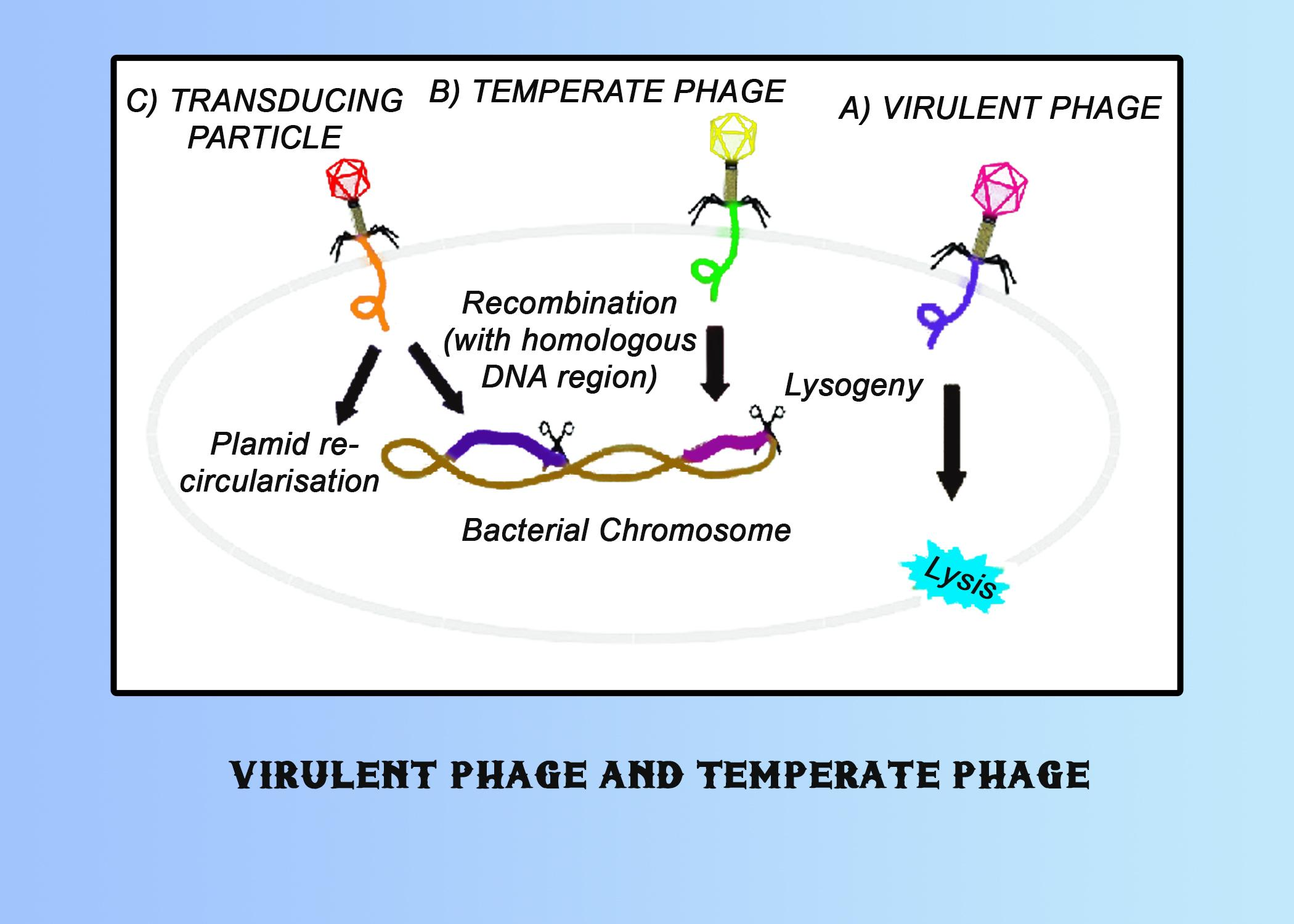
Mention the differences between virulent phages and temperate phages.
Answer
555k+ views
Hint: Virulent phages replicate with the help of lytic cycles whereas temperate phages replicate with both lytic and lysogenic cycles. The phase DNA integrates into the bacterial chromosome and produces the prophage in the lysogenic cycle.
Complete answer:
-Depending on the lifestyle bacteriophages classified into virulent and temperate phages
-Differences between virulent phages and temperate phages.
Additional Information: -The bacteria phase takes command over the cell during the lytic cycle of the virulent phage and there they are able to reproduce new phages and destroy the host cell. A very good example of a well-characterized class of virulent phages is the T-even phage.
-The phage genome made entry to the cell with the help of attachment and penetration in the lysogenic cycle. Lambda phage is a very good example of a phage with this type of life cycle.
-In the lysogenic cycles, phages do not kill the host cell instead they integrate into their chromosomes and become part of it and the phage genome which is integrated into the bacterial chromosome is called a prophage.
-The bacterial host cell with a prophage is known as a Lysogen.
-When the bacteria are infected by a temperate phage, then the process is called lysogeny.

Note: -The lytic and the lysogenic cycles are both performed by the temperate bacteriophages.
-The phage DNA incorporated into the bacterial genome and formed a prophage. This passed to the subsequent generation of the cells.
-Some environmental stress like starvation or toxic chemicals cause the prophage to be excised and enter the lytic cycle.
-Only the lytic cycle can be shown by the virulent phage where they replicate and lyses the host cell.
Complete answer:
-Depending on the lifestyle bacteriophages classified into virulent and temperate phages
-Differences between virulent phages and temperate phages.
| Virulent phage | Temperate phage |
| -These phages are not able to break their host cells and depend on the productive infection cycles for propagation. | -These pages are able to multiply on their host cell which automatically causes the lysis of the cell. Therefore, they integrate their phage genome into the chromosomes of bacteria and become a prophage. |
| -During every infection cycle these phages kill the bacterial cell. | -The bacteria are not killed immediately after the infection by the temperate phages |
| -These phages follow the lytic cycle | -The lytic cycle and lysogenic cycles both are followed by temperate phages. |
| -Virulent phages cause the death of the cell through cell lysis | -These pages easily become part of the bacterial chromosome and replicate in their genomes. They replicate until the time that they are induced to make newly assemble viruses or progeny viruses |
Additional Information: -The bacteria phase takes command over the cell during the lytic cycle of the virulent phage and there they are able to reproduce new phages and destroy the host cell. A very good example of a well-characterized class of virulent phages is the T-even phage.
-The phage genome made entry to the cell with the help of attachment and penetration in the lysogenic cycle. Lambda phage is a very good example of a phage with this type of life cycle.
-In the lysogenic cycles, phages do not kill the host cell instead they integrate into their chromosomes and become part of it and the phage genome which is integrated into the bacterial chromosome is called a prophage.
-The bacterial host cell with a prophage is known as a Lysogen.
-When the bacteria are infected by a temperate phage, then the process is called lysogeny.

Note: -The lytic and the lysogenic cycles are both performed by the temperate bacteriophages.
-The phage DNA incorporated into the bacterial genome and formed a prophage. This passed to the subsequent generation of the cells.
-Some environmental stress like starvation or toxic chemicals cause the prophage to be excised and enter the lytic cycle.
-Only the lytic cycle can be shown by the virulent phage where they replicate and lyses the host cell.
Recently Updated Pages
Master Class 11 Social Science: Engaging Questions & Answers for Success

Master Class 11 Physics: Engaging Questions & Answers for Success

Master Class 11 Maths: Engaging Questions & Answers for Success

Master Class 11 Economics: Engaging Questions & Answers for Success

Master Class 11 Computer Science: Engaging Questions & Answers for Success

Master Class 11 Chemistry: Engaging Questions & Answers for Success

Trending doubts
What is meant by exothermic and endothermic reactions class 11 chemistry CBSE

10 examples of friction in our daily life

Difference Between Prokaryotic Cells and Eukaryotic Cells

1 Quintal is equal to a 110 kg b 10 kg c 100kg d 1000 class 11 physics CBSE

One Metric ton is equal to kg A 10000 B 1000 C 100 class 11 physics CBSE

Draw a diagram of nephron and explain its structur class 11 biology CBSE




